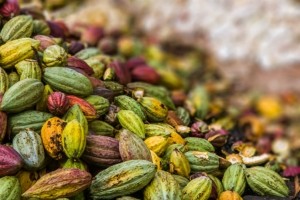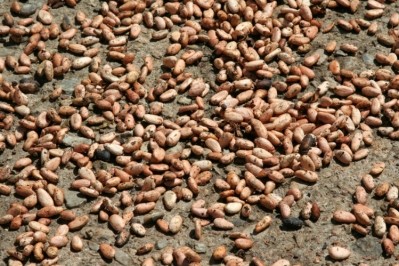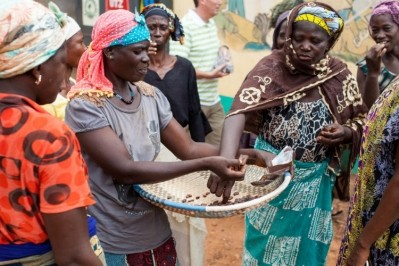Special report - part one
The Right Price: Could premiums paid by the government eradicate child labor in Ghana’s cocoa industry?

Editor's Note: This article is part one of two analyzing the proposal and conclusions of this study. Read part two as three industry players respond and share their perspective on eliminating child labor.
Published in the journal PLOS, the study dissects the trajectory of the industry’s concern with child labor, which it pins to a series of articles and documentaries that revealed enslaved young boys working on cocoa farms in Cote d’Ivoire. Outrage in the UK and other high-income nations ensued, leading chocolate producers to “reassess its influence over the social responsibility” of human rights and welfare in its supply chain.
While the number of kids reported to be working in the system dipped slightly in Ghana, it leapt 20% from 2008 to 2014 in neighboring Côte d’Ivoire, the world’s largest cocoa supplier.
The team of researchers, led by agricultural economists from the University of Arkansas and Kansas State University, contend that the industry thusfar has stopped short of real change: “Their responses were merely reactions and not solutions to child labor.”
In 2001, the Harkin-Engle Protocol sought – by 2020 – to reduce child labor by 70%, the equivalent of about 1.5m children. Genetically modified plants were touted as a possible curb, but the higher-yielding crops required more labor to harvest and process – not less. Governments stepped in with legislation, but enforcement has proven prickly due to the rural nature of cocoa farms and the family tradition inherent to smallholder reality, according to the study.
Without tangible economic incentives, cocoa producers in Ghana and Cote d’Ivoire may not have the time or capacity to respond.
Children working in the fields, the study said, is both a symptom of poverty and a contributing factor: They work to sustain their families’ livelihoods, yes; however, by not attending school, they quash their chances of developing economic independence.
What consumers don’t see

The highest rates of child labor in Africa are not in cocoa-producing nations. More than 40% occurs in Mali, Burkina Faso, Niger, Kenya Uganda, Burundi and Rwanda – all of which predominantly rely on non-cash crops consumed domestically. Why does this matter? The researchers postulate that consumers in high-income countries may wish to eradicate child labor from products they consume, but not care if child labor otherwise plods on. Would such abuse, then, ‘simply reappear’ in other crops that stay within a country’s borders?
Through three theoretical scenarios, the study uses the Farm Household Model (FHM) as a jumping-off point. This analysis considers three factors: production and consumption of cocoa and food staples; demand for production inputs, such as fertilizer, capital or land; as well as labor and leisure decisions.
“If the estimated premium is relatively small enough, then activists and consumers could incentivize the reduction of child labor via price premiums paid to producers, instead of relying on political enforcement that has historically been less effective given the informal nature of the cocoa market.”
#1: Government pushes policy and pays up
This approach is unique because, unlike mandates and international pressure from activists which punish poverty-stricken households who use hazardous child labor, this study estimates a premium to incentivize its reduction.
In the first scenario, COCOBOD enforces the child labor restriction and pays for the price premium.
According to the researchers, the price premium would expand cocoa production as farmers strive to reap more of the benefits of the larger return. Nonetheless, the net price they receive would not rise by the full amount of the premium, in part because most of Ghanaian cocoa is exported – which in turn reduces the world cocoa price.
Net income overall, however, would fall under this scenario by 0.1% to 0.3%.
“As cocoa becomes more valuable (rise in cocoa price paid to farmers) to the household, the adults in the household spend less time at leisure and food cultivation and more time at cocoa cultivation to help augment production,” the authors said.
Simultaneously, food and non-food consumption also falls, which the researchers leads to ‘a key result’: “the restriction (or elimination) of child labor, coupled with a constant utility achieved through cocoa price premiums, not only reduces child labor in cocoa production but also reduces the time children spend in food cultivation while increasing their time spent at leisure and education.”
#2: Restriction but no support
In the second scenario, the government enforces the child labor restriction without compensating farmers through the price premium.
Without compensation, parents have less incentive to abide by the labor restriction, and enforcement is substantially more difficult.
Missing the financial bump, the researchers said, farmers would reduce cocoa production “as they deviate from the optimal labor allocation under the baseline.” The slump in supply would increase the world cocoa price by 0.3% to 7%, but Ghanaian farmers would still not benefit.
Their net income would fall by an amount similar to the first example, in which the government both enforces child labor restrictions and covers the premium.

Because cocoa and food production fall in this scenario, adults spend more time at leisure, though children’s time would mirror the first example due to the imposed labor restriction. They would, however, spend a little less time in leisure and educational activities.
“Without compensation for the child labor restriction, the overall welfare of the farm household declines, and children spend relatively less time at leisure and education as they do when the farm household is fully compensated.
Without compensation, parents have less incentive to abide by the labor restriction, and enforcement is substantially more difficult.”
#3: Consumers walk the talk
In the third scenario, which also entails government oversight of the child labor restriction, consumers pay the price premium for chocolate exported from Ghana. That financial boon encourages farmers to increase their supply, but the higher ticket price at the consumer level diminishes both demand and the world price for cocoa.
Thus, farmers’ net income dips to about the same levels as the second scenario that lacks a price premium all together.
“In general, the more stringent the labor restriction, the less responsive the world cocoa price is to an exogenous increase in the premium,” the researchers said.
“When the consumers pay for the price premium, the world price is distorted while having the exact same impacts on the farmer as with no subsidy.”
A potential solution
Recognizing poverty as the ‘root cause’ of child labor in Ghana’s cocoa sector, the study acquiesces that “very little motivation exists to reduce [it], which is an asset, without an economic incentive to do so.”
In other words, money talks. But in the case of Ghanaian cocoa, it must come from COCOBOD, ‘the nexus’ of private, civic and philanthropic entities equipped to share these ‘considerable’ costs.
The study concludes that a 2.8% premium would reduce the worst forms of child labor. An 11.8% premium stands to cut those forms, including trafficked and bonded labor of long hours in hazardous conditions, as well as regular work by kids in the fields. But to eradicate child labor entirely, down to ‘light work,’ would require a 56% surge.
Only COCOBOD can, one, enforce its own child labor policy; two, compensate farmers for not using it; and three, ensure that the price of cocoa grows (or falls) in accordance with staple crops.
The COCOBOD can make progress in their mission to enhance the competitiveness of Ghana’s cocoa industry by establishing effective policies to produce child-labor free cocoa. These premiums paid to producers need to be viewed as short-term losses to enhance global competitiveness. Otherwise, there could be long-term market share loss as consumers demand cocoa from other production regions.
High-yielding, disease-resistant plants could throw a wrench in any, the researchers caution, as production could jump more than 30% in the next seven years – as it did from 2008 to 2014. Such a surge would require more labor, and there is no telling that children would be omitted.
Now, the authors concluded, is the time to address that possibility.
Study:
Estimating the economic incentives necessary for eliminating child labor in Ghanaian cocoa production
PLOS One: Volume 10, Issue 1371 – June 2019
Authors: J. Luckstead, F. Tsiboe, L.L. Nalley
doi.org/10.1371/journal.pone.0217230













